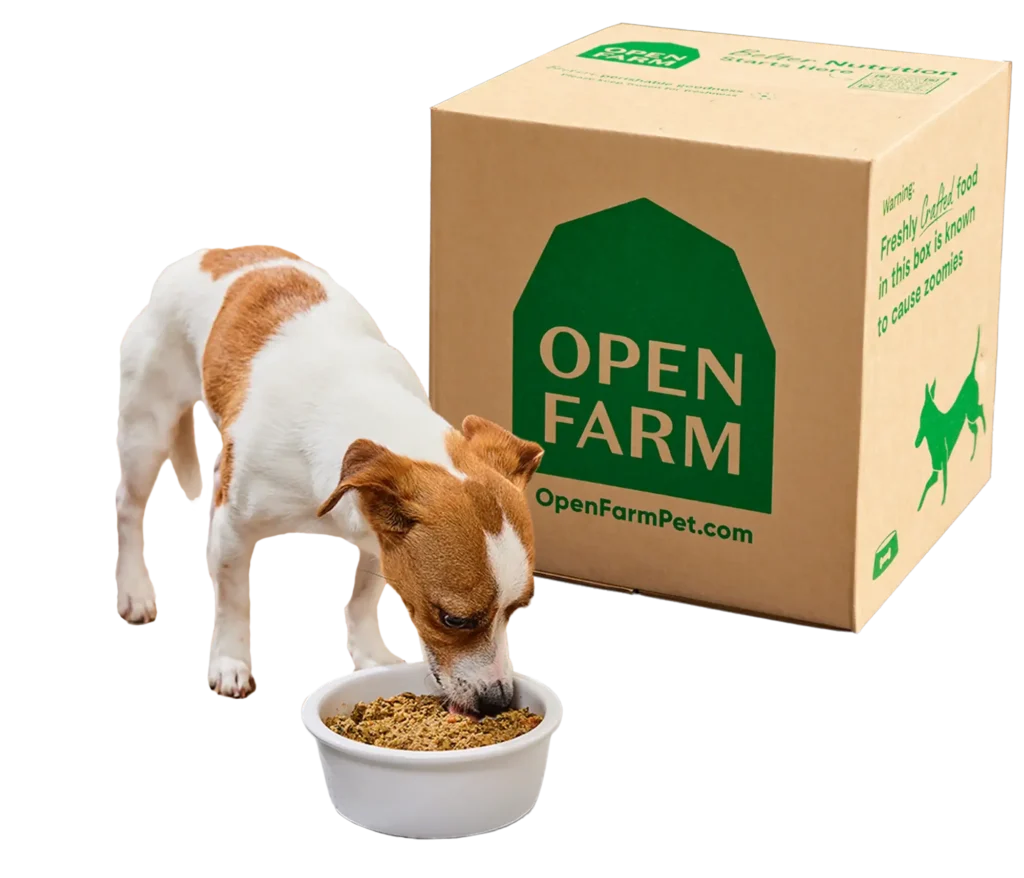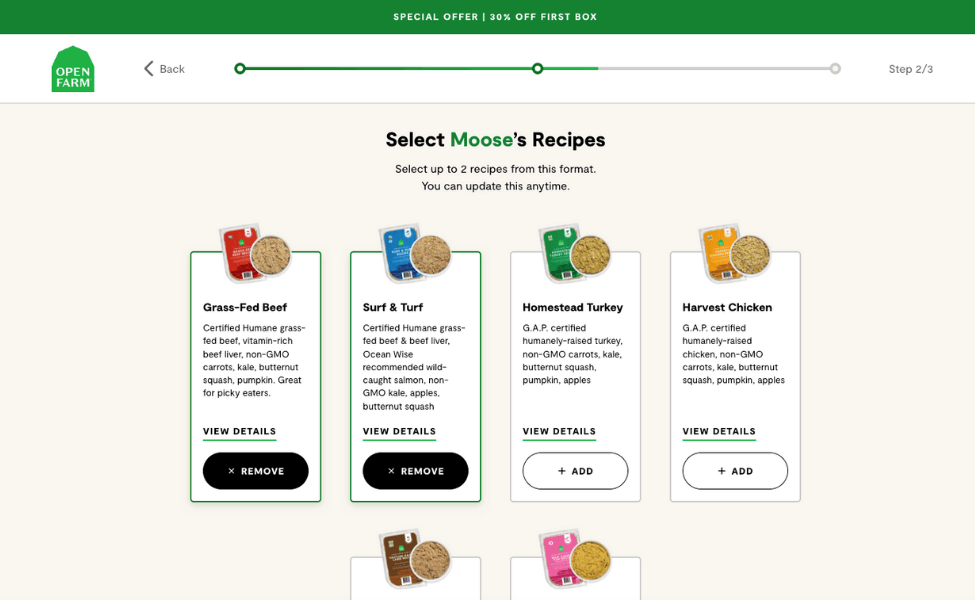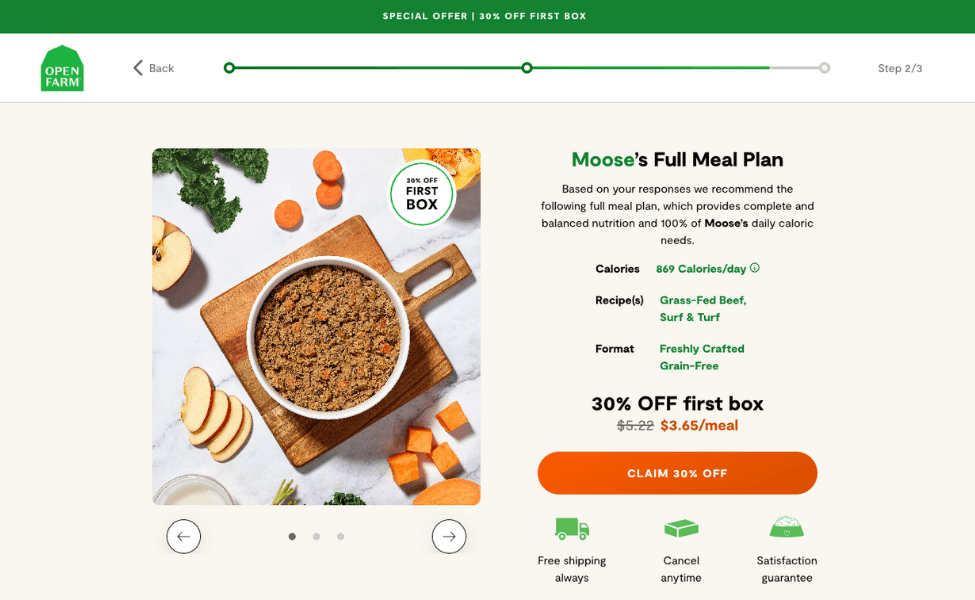

Working as a Animal Nutritionist and a lifelong dog lover.

Working at an animal shelter gives you a unique opportunity to try different dog-food brands. You see firsthand how dogs respond to new diets—picky eaters, sensitive stomachs, and everything in between. When Open Farm reached out about their fresh dog food, I was curious. Their promise of 100% traceable ingredients sounded great, but would it actually make a difference?
At the shelter, we see nutrition issues every day. Poor appetite, dull coats, stomach problems—you name it. Open Farm says its fresh food can address those problems with human-grade ingredients and personalized feeding plans.
What really caught my attention was the transparency philosophy. You can trace every ingredient back to its source. For shelter dogs with unknown histories, that’s invaluable. We often don’t know what they’ve eaten before or what they might react to.
5/5
4.5/5
4.7/5
5/5
4.5/5

We conducted a four-week trial and recorded daily observations. Moose received his Open Farm portions twice daily, following the personalized feeding guidelines. We kept his normal routine:
Morning feeding at 7:30 AM
Evening feeding at 5:30 PM
Daily walks totaling at least 90 minutes
The delivery arrived on time in a well-insulated cooler box. Everything was still perfectly frozen after a full day in transit. The packaging felt premium, with clear labels and portion instructions.
Right away, it smelled fresh—not that typical “dog-food smell,” but more like a meal from your own fridge. The individual portions came pre-packaged in recyclable pouches.
For this test, I chose Moose, a three-year-old Labrador Retriever from American lines. At 66.5 lb, he’s a good “average” dog—neither too big nor too small.
Moose has several traits that made him ideal:
Consistent eater—neither picky nor food-obsessed
Sensitive stomach—reacts quickly to dietary changes
Active but not hyper—easy to spot energy shifts
His charcoal-gray coat with a distinctive white chest patch makes changes in shine easy to see. Labs love food, but Moose is surprisingly moderate. He eats what he needs, nothing more.
Key point: Moose had been dealing with a dull coat and lower-than-usual energy in recent months. Not ill, but not in peak condition either. Exactly the kind of dog where better nutrition might move the needle.
The transition from his standard shelter kibble to Open Farm would be telling. He’d been getting decent, basic kibble—good enough, nothing fancy. The question was: would fresh food with traceable ingredients actually impact his condition?
Before starting Moose on the new diet, I wanted to understand what sets Open Farm apart. It’s more than “fresh food”—it’s a different philosophy about dog nutrition.
Open Farm started in 2014 when three dog lovers grew frustrated with the lack of transparency in pet food. Isaac Langleben, Jacqueline Prehogan, and Derek Beigleman had just adopted their first pugs and couldn’t find food that met their ethical standards.
What really resonates with me is that Jacqueline became vegetarian through her work in the pet-food industry. She saw how things usually work and wanted something different. From three simple kibble recipes, Open Farm has grown to 100+ products, now available in 6,000+ stores across North America.
The company is a Certified B Corporation with a score of 102.8—remarkably high for a dog-and-cat-food brand in North America. That speaks to a serious commitment to responsible business.
The difference between Open Farm’s fresh food and regular kibble is bigger than you’d think. With fresh food, you see real ingredients—actual pieces of meat and recognizable vegetables. Not the vague “meat and animal by-products” you see on many kibble bags.
Key differences:
Moisture content: ~70–75% in fresh food vs. ~10% in kibble
Preparation: Slow-cooked at low temperature vs. high-heat extrusion
Shelf life: Must stay frozen vs. months on the shelf
Price: ~$4–12 per day vs. ~$1–4 for kibble
For Moose, his meals looked like something I could eat myself. Digestibility is notably better—important for sensitive stomachs. The trade-off: you need freezer space and you have to plan ahead for thawing.
This is what impresses me most about Open Farm. A QR code on every package lets you see where each ingredient comes from—down to the state or province for North American sources.
You can check:
Geographic origin of every ingredient
Safety test results by batch
Animal-welfare certifications
Product carbon footprint
I tested this and was impressed. You can see, for example, that the beef comes from specific humane farms without growth hormones. The vegetables are non-GMO and you can see the region they’re from. For a shelter dealing with unknown allergies, that level of clarity is incredibly useful.
Open Farm’s fresh line is called Freshly Crafted and uses a steam sous-vide process—think slow cooking for dog food. It kills bacteria while preserving nutrients.
The recipes come in different formats:
Pre-portioned pouches (easy measuring)
Meatballs (convenient to portion)
Rolls you slice
For Moose, I tested Grass-Fed Beef. Other options include Surf & Turf (beef and salmon), Wild-Caught Fish, and a Tummy Rescue formula for sensitive stomachs. Each recipe includes visible superfoods like pumpkin, kale, and coconut oil.
Practically speaking: everything arrives frozen and stores in your freezer until needed. Portions are pre-measured by weight, so no messing with scales. In a busy shelter, that saves time.


When I opened Moose’s food, I could actually see what was in it—chunks of meat, recognizable vegetables, no mysterious brown pellets. Here’s what’s inside.
Open Farm sources meat from third-party-certified farms with strict animal-welfare standards. For Moose, I mainly used Grass-Fed Beef, but there are multiple proteins:
Beef: G.A.P. Step 4 certified, grass-fed, no antibiotics
Chicken: Free-range, G.A.P. Step 2
Fish: 100% wild-caught, Ocean Wise approved
Lamb: Pasture-raised, no growth hormones
Vegetables are largely locally sourced—about 40% are grown in the same city as the production facility. You’ll see carrots from Canada, kale from South Carolina, pumpkin from Honduras. All non-GMO.
Early on, Moose carefully ate around certain vegetable pieces; after a few days he ate everything with equal enthusiasm. The coconut oil lends a pleasant aroma—very different from typical wet food.
Superfoods add extra appeal: chia seeds for omega-3s, turmeric as a natural anti-inflammatory, and dried seaweed from Iceland for minerals. Considering how many shelter dogs struggle with inflammation issues, that’s a welcome addition.
This might matter more than what is. Open Farm leaves out a lot of things you find in standard dog food.
No problematic grains: no corn, wheat, or soy. Moose doesn’t have known allergies, but we’ve seen plenty of dogs develop itching or digestive issues from those.
No artificial additives: no dyes, flavors, or preservatives like ethoxyquin. They use natural vitamin E for preservation. Once thawed, use within 3 days in the fridge.
No vague fillers: you won’t see “meat and animal by-products.” No mystery “meat meal.” Everything is traceable and specifically named.
The numbers are solid. On a dry-matter basis, the fresh food averages about 38.8% protein—higher than many premium kibbles. Fat runs around 28%, ideal for active dogs like Moose.
For his daily portion, that meant:
~11.6 oz per meal (twice daily)
~1,300 kcal per kilogram of food
~11% protein on an as-fed analysis
With ~70–75% moisture, Moose also got more hydration. At the shelter, we often see dogs that don’t drink enough—fresh food helps solve that.
All recipes are formulated to meet AAFCO nutrient profiles for complete nutrition. They also include added taurine for heart health. Dry recipes list about 0.25% taurine; Freshly Crafted includes added taurine as well (amount varies by recipe).
Vitamins and minerals are chelated—better absorbed than cheaper forms. Zinc for skin, iron for anemia, copper for coat. After about three weeks, I saw a clear difference in Moose’s shine.
What convinces me most: you can view test results online—batch-specific lab results for pathogens, heavy metals, and nutrition. In a shelter setting, where we must justify what we feed, that transparency matters.
One trade-off: at around 21% carbohydrates, it’s not the lowest out there. But carbs come from quality sources like sweet potato and pumpkin—not cheap fillers.
Open Farm’s ordering process felt surprisingly personal. Instead of just tossing a bag into your cart, you’re guided through a short quiz about your dog. For Moose, I filled in everything—from his 66.5 lb to his moderate activity level.
The quiz goes beyond weight and age. It asks about pickiness, activity level, and any health issues. For Moose, I indicated that he’s a steady eater with a slightly sensitive stomach.
The system immediately calculated his daily intake. At his weight, it came to about 23 oz per day, split between two meals. It also estimated how many boxes we’d need per month.
Recipe formats were flexible:
Grain-free pouches (scoopable bags)
Sliceable rolls
Meatballs for easy portioning
Targeted options like Tummy Rescue
For Moose, I chose Grass-Fed Beef rolls—easy to slice and gentle on his stomach. The subscription is fully flexible. You can adjust delivery frequency from weekly to every 16 weeks. No contracts.
The first order is 30% off, then 5% off subsequent deliveries. On a limited shelter budget, every discount helps. You can even manage deliveries via SMS—handy when you’re busy with the dogs.
Delivery arrived within three days—faster than expected. The box was well insulated with dry ice, and everything was still frozen. It stays cold for hours if you’re not home.
The packaging was sustainable yet effective—recyclable cardboard with minimal plastic. Open Farm also runs a return program for empty packaging and is aiming for zero waste.
Individual portions were clearly labeled with QR codes. Scan the code to see ingredient origins. For a shelter focused on transparency, that’s perfect.
Storage instructions:
Straight to the freezer (stores for months)
Thaw in the fridge (plan about 24 hours ahead)
Once thawed, use within 3 days
Do not refreeze
The rolls had convenient markings—each line is about 2 oz. For Moose, that meant roughly 11–12 lines per day. Couldn’t be easier.
One downside: you need meaningful freezer space. A month’s supply for Moose took a full shelf. If your freezer is small, plan accordingly.
Customer service deserves praise. I asked about transitioning from Moose’s old food and got an answer within an hour via chat—including a personalized transition schedule for his sensitive stomach.
Overall, it felt premium yet straightforward. From ordering to feeding, the process was well thought out. You do have to remember to thaw on time. More than once, I stared at a frozen roll at 7:30 AM because I forgot.


For four weeks, Moose ate Open Farm Grass-Fed Beef daily. No other treats, no extras—pure focus on how this food would affect him. Here’s what happened.
I took it slow because of Moose’s sensitive stomach. Day 1 was 75% old kibble, 25% Open Farm.
The fresh food smelled different right away—like real food. Moose sniffed cautiously at first, then ate the Open Farm portion first and looked less excited about the kibble.
By day 4 we were at 50/50. His stool got a bit softer—normal during a transition. No diarrhea, just consistency changes. He also drank less water, which makes sense given the moisture content.
By day 7, he was fully transitioned. No stomach upset, no refusal. For a Lab with sensitive intestines, that’s a smooth switch.
In week 2, the real changes began. Moose’s energy level ticked up—not hyper, just more alert on walks. He played longer with other shelter dogs without tiring as quickly.
His stool stabilized and became smaller and firmer—about a 40% volume reduction. Less cleanup is always welcome. The smell was also less pungent. If you clean kennels daily, you notice things like that.
His coat started changing around day 10. The dull, dry spots on his back looked shinier. His white chest patch looked brighter. Labs naturally have an oily coat, but Moose shifted from flat to healthy sheen.
By week 3, something unexpected happened: Moose grew pickier about treats. Standard cookies didn’t tempt him. As if his palate got more discerning.
Feeding became routine. Morning portion from the fridge, let it sit for ~10 minutes, serve. He licked the bowl so clean rinsing felt optional.
After four weeks, the transformation felt complete. Moose still weighed 66.5 lb—no weight change—but his body felt firmer. More muscle tone, less softness around the middle.
Main changes:
Coat: from dull gray to charcoal with a noticeable gloss
Energy: consistently higher, especially on afternoon walks
Stool: ~40% less volume, much firmer
Feeding behavior: more enthusiasm at mealtimes, less interest in treats
What I noticed most was his overall mood. Moose seemed happier—more tail wags, more engagement, more focus in training. Maybe I’m projecting, but the difference was hard to miss.
A small bonus: his breath smelled better. Labs aren’t famous for fresh breath, but it improved. Tartar looked slightly reduced, though four weeks is too short for firm conclusions.
The biggest hassle remained thawing. Twice I forgot to move a roll to the fridge at night. Morning panic, quick thaw in lukewarm water—not ideal, but it worked.
Let’s be honest—Open Farm isn’t cheap. For Moose at 66 lb, it came to about $210 per month. That’s nearly three times premium kibble. But here’s why it may still be worth it.
Approximate daily costs as a complete diet:
Small dogs (≈10 lb): ~$4–5 per day ($120–150/month)
Medium dogs like Moose (≈60–70 lb): ~$7–8 per day ($210–240/month)
Large dogs (≈110+ lb): ~$12–15 per day ($360–450/month)
The 30% discount on your first box helps. For Moose, that saved ~$63 in month one. After that, 5% off with a subscription softens the blow, but it’s still a significant spend.
One thing to consider: due to higher digestibility (often cited around the low-80% range vs. ~70% for kibble), you typically need less food. Moose ate ~23 oz of Open Farm per day, compared with ~26 oz of kibble. That offsets cost somewhat.
The benefits I saw in Moose:
Shinier coat within two weeks
More steady energy without jitters
~40% less stool (and less odor)
Better digestion and hydration
Beyond what you can see, fresh food often aligns with lower inflammation markers and improved overall wellness. At the shelter, chronic issues tied to poor diets are common:
Skin problems: $500–1,500 per year
GI issues: $300–1,000 per year
Joint problems: $1,000–3,000 per year
If better nutrition helps reduce the frequency or severity of those, $200/month can make sense.
For Moose, better nutrition also meant he was more adoptable. A healthy, energetic dog with a glossy coat finds a home faster than a dull, listless one. That alone matters to us.
My advice? Try it for a month. With the 30% intro discount and a 30-day satisfaction guarantee, the risk is low. If after four weeks you see what we saw with Moose, you’ll know it’s worth it. You can also compromise: feed 50/50 with quality kibble or use Open Farm as a topper. You’ll capture many benefits for less.
Bottom line: what is your dog’s health and well-being worth to you? After Moose’s results, my answer is clear. The extra energy, better digestion, and visible coat change are hard to ignore.
Open Farm delivers on its promises. In my experience, you see results quickly: a shinier coat, more consistent energy, and smaller, firmer stools with less odor. The QR-code transparency and batch testing inspire confidence—especially if your dog is reactive or you want to know exactly what’s in the bowl.
Digestibility is strong, and you notice it at home and on walks. If your dog often has soft stool or seems sluggish on kibble, this may be the boost they need. Many owners report renewed appetite—and I saw that here.
There’s a clear price tag: for a medium-size dog, plan on ~$210–240/month, usually ~30% off the first box and ~5% after. You’ll also need freezer space and some thawing discipline; if you forget often, it becomes a hassle. Still, you’re buying quality and peace of mind.
Want to start without regrets? Transition gradually over 7–10 days and watch coat, stool, energy, and appetite. If the monthly cost stings, mix 50/50 with quality kibble or use Open Farm as a daily topper. You’ll get most of the upside for fewer dollars.
My final verdict: Open Farm checks all the right boxes for quality, sourcing, and practical feeding. It’s not cheap, but if your dog thrives like Moose did, the investment makes sense. More shine, better digestion, and more enjoyment at mealtimes—and for you, a dog who simply feels better overall.


An in-house R&D team that includes an animal nutritionist (MSc) and a PhD food scientist in Toronto. The recipes are technically sound and nutritionally complete.
Not by default. The focus is on Certified Humane standards for higher animal welfare. That often provides more meaningful guarantees about sourcing and treatment than an organic label alone, though it doesn’t require organic feed.
As of this writing, I’m not aware of any product recalls.
Most are gluten-free, though not produced in a gluten-free facility (trace amounts possible). Ancient Grains and Kind Earth Plant Kibble contain gluten (including barley).
Mostly Canada and the US. Exceptions include coconut oil (Indonesia/Philippines/Thailand), some vitamins/minerals (Europe), and certain proteins like lamb/venison (New Zealand). You can view batch-specific origins.
Always wild-caught fish; species varies by season for freshness and sustainability. Nutritional profiles remain consistent across batches.
Usually 7–10 days:
Days 1–3: 75% old, 25% Open Farm
Days 4–6: 50/50
Days 7–9: 25% old, 75% Open Farm
Day 10: 100% Open Farm
Within the same product category, usually yes. For richer or higher-protein lines (e.g., RawMix), consider a mini-transition.
Yes. Most recipes cover all life stages; there are also puppy and senior options for added customization.
Yes. They’re complete and balanced and formulated to meet AAFCO nutrient profiles—suitable as a full meal.
Very flexible: adjust, pause, or skip anytime. SMS management works well. Make changes before processing to avoid unwanted shipments.
In your account under “Manage My Subscriptions” or through support. Make changes before your order processes.
Usually 3–5 business days. Freshly Crafted arrives frozen on dry ice and reliably cold.
Email support 24/7; responses typically within 24–48 hours
Phone Mon–Fri 9:00 AM–5:00 PM ET (1-833-399-3403)
Live chat Mon–Fri 9:00 AM–7:00 PM ET
A 30-day satisfaction guarantee for new customers and new recipes. If it doesn’t work for your dog, you can request a full refund within 30 days of delivery.
Go slower (10+ days), start with smaller portions, and consider Tummy Rescue. Monitor stool and appetite; for persistent issues, consult your veterinarian.
During transition, some dogs experience soft stool or gas—especially with higher protein. That’s usually temporary; slow the transition if needed.
Try a different protein or format (rolls, pouches, meatballs). Serving at room temperature often helps. Not sure? Ask the Pet Feeding Experts for tweaks.
As a complete fresh diet, plan roughly: small (~10 lb) $4–5/day, medium (~60–70 lb) $7–8/day, large (~110+ lb) $12–15/day. You’re paying for quality and digestibility; many owners see that reflected in coat, energy, and stool quality.
Not free, but you typically get 30% off your first meal-plan box plus a 30-day satisfaction guarantee—enough to test without regret.
They’re formulated to meet AAFCO nutrient profiles and supported by third-party testing.
Dry recipes list about 0.25% taurine; Freshly Crafted includes added taurine for completeness (amount varies by recipe).
Yes. Slice rolls or break meatballs into small pieces, and adjust meals to avoid overfeeding. It’s often a good option for sensitive stomachs.
